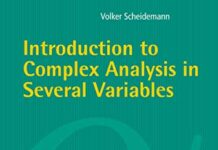
Ebook Info
- Published: 2005
- Number of pages: 179 pages
- Format: PDF
- File Size: 7.48 MB
- Authors: Volker Scheidemann
Description
This book provides a comprehensive introduction to complex analysis in several variables. One major focus of the book is extension phenomena alien to the one-dimensional theory (Hartog’s Kugelsatz, theorem of Cartan-Thullen, Bochner’s theorem). The book primarily aims at students starting to work in the field of complex analysis in several variables and teachers who want to prepare a university lecture. Therefore, the book contains more than 50 examples and more than 100 supporting exercises.
User’s Reviews
Editorial Reviews: Review This is a book written with the student in mind: it offers a concise treatment of complex analysis in several variables, by focusing on special topics rather than trying to be a comprehensive treatment of the subject. (…) The main importance of this book is the fact that it fills a void: there are relatively few books on several complex variables. Any (graduate) student beginning work in this area and any instructor considering teaching a course in several complex variables should definitely take a look at Professor Scheidemann’s work.MAA-Reviews From the Back Cover This book gives a comprehensive introduction to complex analysis in several variables. It clearly focusses on special topics in complex analysis rather than trying to encompass as much material as possible. Many cross-references to other parts of mathematics, such as functional analysis or algebras, are pointed out in order to broaden the view and the understanding of the chosen topics. A major focus is extension phenomena alien to the one-dimensional theory, which are expressed in the famous Hartog’s Kugelsatz, the theorem of Cartan-Thullen, and Bochner’s theorem. The book primarily aims at students starting to work in the field of complex analysis in several variables and teachers who want to prepare a course. To that end, a lot of examples and supporting exercises are inserted throughout the text, which will help students to become acquainted with the subject.
Reviews from Amazon users which were colected at the time this book was published on the website:
⭐I strongly recommend this excellent text on holomorphic functions of several complex variables to anyone interested in a quick introduction the the beautiful world of SCV. It will be of particular use for self-study by anyone with a solid background in 1-complex variables as well as by algebraists looking for clear applications of commutative ring theory.The first 2/3rds of the book concentrate on the basics of the classical theory — power series, Reinhard domains, convexity, the C-R equations, the d-bar operator, and Cauchy’s integral Formula are carefully developed and then applied to domains of holomorphy where many of the fundamental extension theorems are carefully proven. Holomorphic convexity, tubular domains and Cartan-Thullen theory are also introduced.The last parts of the book take on a more modern approach, with algebraic methods coming to the front. The Weierstrass theorems are proven, Dolbeaut cohomology is introduced, and sheaves gently make an appearance, although the term is lacking, via germs. I found this part especially nice, since he actually applies many abstract algebraic tools in a concrete setting. No unnecessary machinery appears. Instead, the reader will find clear examples of how that machinery is actually used in analysis.In fact, the examples and exercises make this volume stand out from other standard, more advanced, texts (e.g., Hormander or Krantz).If I have one point of issue with the author it’s his avoidance of diagrams. Admittedly, as he states in the Preface, attempts to illustrate objects in 4-space can be misleading. But, I find just drawing a picture in absolute space helps clarify some ideas, such as Reinhard and tubular domains and Hartog’s figures.I also have a minor quibble: In discussing the Weierstrass theorems, he uses what I found to be somewhat awkward and non-standard terminology, specifically “z_n general of order m” and “shearing.” I wonder why he didn’t simply say unitary change of variables and be done with it. Some other notation is a bit non-standard, but fortunately, the author includes an index of symbols.Overall, this is one of the very best introductions to the subject, and I find myself repeatedly referring to it when in need of a clear explanation of some topic. It should find a place on any serious mathematician’s bookshelf.
⭐
Keywords
Free Download Introduction to Complex Analysis in Several Variables 2005th Edition in PDF format
Introduction to Complex Analysis in Several Variables 2005th Edition PDF Free Download
Download Introduction to Complex Analysis in Several Variables 2005th Edition 2005 PDF Free
Introduction to Complex Analysis in Several Variables 2005th Edition 2005 PDF Free Download
Download Introduction to Complex Analysis in Several Variables 2005th Edition PDF
Free Download Ebook Introduction to Complex Analysis in Several Variables 2005th Edition
